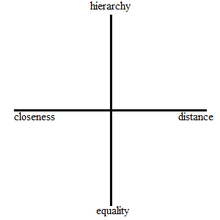Transcription in the linguistic sense is the systematic representation of spoken language in written form. The source can either be utterances or preexisting text in another writing system.

Conversation is interactive communication between two or more people. The development of conversational skills and etiquette is an important part of socialization. The development of conversational skills in a new language is a frequent focus of language teaching and learning. Conversation analysis is a branch of sociology which studies the structure and organization of human interaction, with a more specific focus on conversational interaction.

Conversation analysis (CA) is an approach to the study of social interaction that empirically investigates the mechanisms by which humans achieve mutual understanding. It focuses on both verbal and non-verbal conduct, especially in situations of everyday life. CA originated as a sociological method, but has since spread to other fields. CA began with a focus on casual conversation, but its methods were subsequently adapted to embrace more task- and institution-centered interactions, such as those occurring in doctors' offices, courts, law enforcement, helplines, educational settings, and the mass media, and focus on multimodal and nonverbal activity in interaction, including gaze, body movement and gesture. As a consequence, the term conversation analysis has become something of a misnomer, but it has continued as a term for a distinctive and successful approach to the analysis of interactions. CA and ethnomethodology are sometimes considered one field and referred to as EMCA.
Assertiveness is the quality of being self-assured and confident without being aggressive to defend a right point of view or a relevant statement. In the field of psychology and psychotherapy, it is a skill that can be learned and a mode of communication. Dorland's Medical Dictionary defines assertiveness as:

Discourse analysis (DA), or discourse studies, is an approach to the analysis of written, spoken, or sign language, including any significant semiotic event.
Robin Tolmach Lakoff is a professor emerita of linguistics at the University of California, Berkeley. Her 1975 book Language and Woman's Place is often credited for making language and gender a major debate in linguistics and other disciplines.

Rudeness is a display of actual or perceived disrespect by not complying with the social norms or etiquette expected within a relationship, social group, or culture. Social norms are established as the essential guidelines of normally accepted behavior within a given context, and individuals often establish personal boundaries to meet their own needs and desires within smaller settings, such as friendships. To be unwilling to align one's behavior with these norms known to the general population of what is socially acceptable is to be rude. These norms may resemble a sort of "unspoken law", with social repercussions or rewards for violators or advocates, respectively.

That's Not What I Meant! How Conversational Style Makes or Breaks Relationships is Deborah Tannen's first book presenting, for a general audience, her linguistic approach to explaining how ways of speaking affect relationships. Predating by four years her phenomenally bestselling book about gender differences in ways of speaking, You Just Don't Understand, this book approaches communication and miscommunication from a linguistic point of view rather than a psychological one, emphasizing differences between the genders. The book lays out the linguistic devices and rituals that constitute "conversational style", such as indirectness, pacing, pausing, humor, overlap, and interruption, and shows their effects when styles differ.
Difference theory, broadly, is based on studies of communication and other interactions that find cultural differences between men and women.
Research into the many possible relationships, intersections and tensions between language and gender is diverse. It crosses disciplinary boundaries, and, as a bare minimum, could be said to encompass work notionally housed within applied linguistics, linguistic anthropology, conversation analysis, cultural studies, feminist media studies, feminist psychology, gender studies, interactional sociolinguistics, linguistics, mediated stylistics, sociolinguistics, and feminist language reform and media studies.
Interactional linguistics (IL) is an interdisciplinary approach to grammar and interaction in the field of linguistics, that applies the methods of Conversation Analysis to the study of linguistic structures, including syntax, phonetics, morphology, and so on. Interactional linguistics is based on the principle that linguistic structures and uses are formed through interaction and it aims at understanding how languages are shaped through interaction. The approach focuses on temporality, activity implication and embodiment in interaction. Interactional linguistics asks research questions such as "How are linguistic patterns shaped by interaction?" and "How do linguistic patterns themselves shape interaction?".

You Just Don't Understand: Women and Men in Conversation is a 1990 non-fiction book on language and gender by Deborah Tannen, a professor of sociolinguistics at Georgetown University. It draws partly on academic research by Tannen and others, but was regarded by academics with some controversy upon its release. It was written for a popular audience, and uses anecdotes from literature and the lives of Tannen and her family, students and friends.
Interactional sociolinguistics is a subdiscipline of linguistics that uses discourse analysis to study how language users create meaning via social interaction. It is one of the ways in which linguists look at the intersections of human language and human society; other subfields that take this perspective are language planning, minority language studies, quantitative sociolinguistics, and sociohistorical linguistics, among others. Interactional sociolinguistics is a theoretical and methodological framework within the discipline of linguistic anthropology, which combines the methodology of linguistics with the cultural consideration of anthropology in order to understand how the use of language informs social and cultural interaction. Interactional sociolinguistics was founded by linguistic anthropologist John J. Gumperz. Topics that might benefit from an Interactional sociolinguistic analysis include: cross-cultural miscommunication, politeness, and framing.
Susan Catherine Herring is an American linguist and communication scholar who researches gender differences in Internet use, and the characteristics, functions, and emergent norms associated with language, communication, and behavior in new online forms such as social media. She is Professor of Information Science and Linguistics at Indiana University Bloomington, where she founded and directs the Center for Computer-Mediated Communication. In 2013 she received the Association for Information Science & Technology Research Award for her contributions to the field of computer-mediated communication. She has been a fellow at the Center for Advanced Study in the Behavioral Sciences at Stanford University. Herring also founded and directed the BROG project.

Turn-taking is a type of organization in conversation and discourse where participants speak one at a time in alternating turns. In practice, it involves processes for constructing contributions, responding to previous comments, and transitioning to a different speaker, using a variety of linguistic and non-linguistic cues.

Elizabeth Stokoe is a British social scientist and conversation analyst. Since January 2023, she has been Professor in the Department of Psychological and Behavioural Science at The London School of Economics and Political Science. She was previously Professor of Social Interaction at Loughborough University (2002-2022) in the Discourse and Rhetoric Group, where she remains an Honorary Professor. She has been Professor II at University of South-Eastern Norway since 2016.
Susan Lynn Ehrlich is a Canadian linguist known for her work in both language and gender, language and the law, and the intersections between them. She studies language, gender and the law, with a focus on consent and coercion in rape trials.
Deborah Sue Schiffrin was an American linguist who researched areas of discourse analysis and sociolinguistics, producing seminal work on the topic of English discourse markers.
An interruption is a speech action when one person breaks in to interject while another person is talking. Linguists, social psychologists, anthropologists, and sociologists are among the social scientists who have studied and identified patterns of interruption that may differ by gender, social status, race/ethnicity, culture, and political orientation.
Suzanne Eggins is an Australian linguist who is an Honorary Fellow at Australian National University (ANU), associated with the ANU Institute for Communication in Health Care. Eggins is the author of a best selling introduction to systemic functional linguistics and she is known for her extensive work on critical linguistic analysis of spontaneous interactions in informal and institutional healthcare settings.










